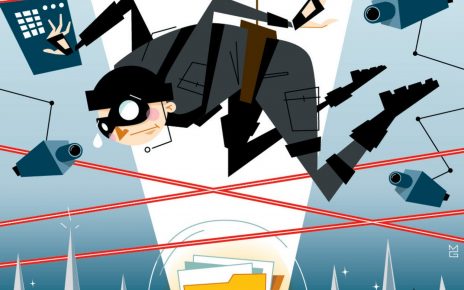The magician climbs into the cage to perform a show for one. For this special event, he eschews coins and cards for peanuts. He rolls his sleeves and faces his captive audience: a corvid bird by the name of Stuka. He shows Stuka a peanut and waves it through the air, sweeping it from one hand to another. Stuka tracks the treat, moving its head like a spectator at a tennis match. Then the magician opens his right hand and shows … nothing! The nut has disappeared! Stuka seems to look around for the missing legume, but the magician pulls it from inside his mouth. Was it there all along? Now the magician vanishes the peanut again, pulling it from his ear next. The peanut keeps magically switching from one place to another, and a second bird approaches to watch, perhaps out of curiosity. The question is, what are those birdbrains thinking?
Elias Garcia-Pelegrin learned to perform magic as an undergraduate student studying drama at University College London (UCL). Upon graduating—and realizing that acting wouldn’t pay the bills—he worked as a bar magician. He also took a job as a zookeeper in an aquarium and grew fascinated with the possible role of social transmission in the mating rituals of penguins. By then, he had gone back to college for a second degree in psychology. Now a Ph.D. student at the University of Cambridge, Garcia-Pelegrin is set to apply his multifaceted background in psychology, zoology and magic to the study of animal cognition.
Garcia-Pelegrin’s approach, presented in a recent Science perspective co-authored by Alexandra Schnell, Clive Wilkins, and Nicola S. Clayton, follows in the footsteps of research deploying visual illusions to better understand perception in such disparate species as lions, horses, monkeys and bees. Their framework also extends prior explorations of the intersection of magic, psychology and neuroscience in subjects ranging from human audiences to nonhuman minds.
Since the late 2000s, cognitive scientists increasingly have exploited magic tricks to delve into the human psyche, sometimes in explicit partnership with professional magicians. One example is the Magic of Consciousness Symposium in 2007, which brought together neuroscientists and magicians such as Teller, Apollo Robbins and James Randi, and led to a joint academic article proposing collaboration between both spheres. In 2008, a follow-up article in Scientific American coined the word neuromagic to describe the nascent field of enquiry. Dozens of research papers using magic to explore human perception and cognition have been published in the intervening years.
The foundations for probing animal minds with magic are solid, given the abundant evidence of misdirection and deception in many species. For instance, chimpanzees look away from desired objects to thwart possible competitors, and jays (corvids) protect their food caches by pretending to store food in bogus locations.
There is also reason to believe that animals can be fooled by human trickery. Animal scientists occasionally use techniques related to magic to investigate cognition, such as invisible string—used for levitation effects—or the shell game. However, it is important to consider species-specific behavior, warns animal cognition expert Irene Pepperberg. Because parrots don’t store food, experiments having to do with episodic memory and caching behavior make little sense in parrots. “But in terms of object permanence there is as much work on parrots as there is on corvids,” Pepperberg says.
Viral YouTube videos also feature sleight-of-hand demonstrations by human conjurers to dogs, chimps and baboons, spurring emotions that seem to range from amusement to annoyance. If you have ever played a game of fetch with your dog, withholding a stick while pretending to throw it, you have performed a rudimentary form of magic, coarsely related to the classical vanishing ball illusion.
Garcia-Pelegrin understands the apparent frustration sometimes expressed by his unusual audiences. “In a typical magic show, the stakes are very low for audience members,” he says. “Even if the magician takes somebody’s wallet, that person knows they’ll get it back at the end of the show.” In contrast, when a magician performs for an animal, they may engage attention by handling food (a high-stakes reward) that mysteriously appears or disappears. The social contract that makes magic feel safe to human audiences does not necessary apply to animal spectators.
Primatologist Frans de Waal points out, in addition, that nonhuman audiences may be less than enchanted by human magicians. “We know that even chimpanzees don’t pay the same attention to humans compared to their own species. This is recognized as the main problem with human-administered tests of chimpanzee cognition. Perhaps magicians would need to be conspecifics for this method to work? This would complicate things considerably,” he says.
Jamy Ian Swiss, a sleight-of-hand magician, skeptic and wildlife activist, also ponders the unforeseen assumptions that animals might make during a magic performance. “An adult will generally fall for a false transfer like the French drop, but a child witnessing the same false transfer will immediately know where the object is, because they do not make all the assumptions that adults make. If the bird is operating at a child’s level, then it’s not going to be making the conventional assumptions [expected from an adult].”
Despite such limitations, Pepperberg thinks that the strategy may produce big returns: “We get a glimmer of knowledge when we get these kinds of reactions,” because they hint at the animals’ awareness of their own cognition. So, what is the most important unanswered question in animal cognition this type of research could address? “I would say consciousness,” Pepperberg says.



